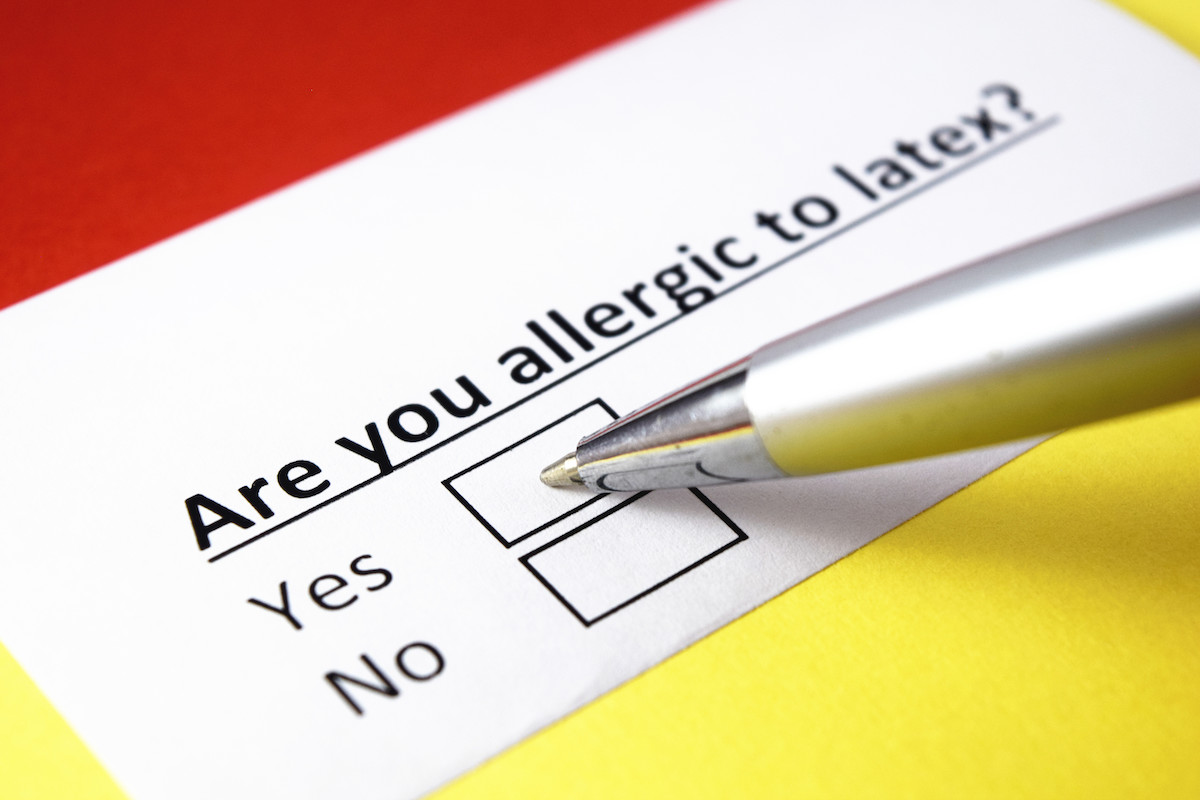
Latex allergy symptoms can range from mild to life-threatening. Here’s what you need to know.
The last time you went to the doctor, you might have been asked whether you’ve ever had an allergic reaction to latex. That’s because certain products that are used in medical settings — like gloves and bandages — can contain latex, a natural material that comes from a milky liquid in rubber trees.
But the doctor’s office isn’t the only place where you might encounter latex. It’s also used in everything from dishwashing gloves, clothing waistbands, balloons, toys and pacifiers to condoms, sanitary pads, adhesive tape, bandages and rubber bands.
What is a latex allergy?
If you’re allergic to latex, your immune system overreacts to this natural substance, thinking it’s a threat.
Latex gloves can be especially problematic, because the latex proteins can attach to the powder that lines the gloves, so when the gloves are taken off, the particles can become airborne.
Fortunately, many hospitals are moving away from latex gloves and other latex products.
“Latex allergy was the most prevalent in the 1990s, when the use of latex gloves was more common,” says S. Cindy Xi, MD, an allergist/immunologist at Keck Medicine of USC and clinical associate professor of medicine at the Keck School of Medicine of USC. “Since the introduction of low-latex or latex-free gloves, new cases of latex allergy have dramatically decreased. And now that most medical centers are latex-free or almost latex-free, the overall incidence of latex allergy has also dramatically decreased.”
What are the symptoms of a latex allergy?
Latex allergy symptoms can range from mild to life-threatening. They can include:
- Rash. Rash is the most common symptom of a latex allergy, Dr. Xi explains. “A rash can develop within minutes of touching latex, and it usually resolves within hours,” she says. “You can also develop a delayed rash that occurs days after exposure to latex and lasts days to weeks. People with eczema may also find that latex is a trigger or exacerbating factor for their eczema,” Dr. Xi adds.
- Respiratory symptoms. Latex can trigger a runny nose, sneezing, congestion, cough, wheezing or shortness of breath, according to Dr. Xi.
- Anaphylaxis. In severe cases, latex can trigger a systemic reaction, called anaphylaxis, which includes symptoms such as difficulty breathing, confusion, dizziness, rapid or weak pulse, nausea, vomiting or loss of consciousness. Anyone with symptoms of anaphylaxis should seek immediate medical attention.
Who’s at risk for a latex allergy?
Health care workers and food industry workers are at higher risk for a latex allergy, but Dr. Xi says there is still more to learn about its causes.
“Latex allergy is most likely to occur in individuals who have both a genetic predisposition to develop allergies and repeated exposure to latex,” Dr. Xi says.
People who’ve had multiple surgeries also have repeated exposure, and therefore, are at a higher risk as well.
“People with spina bifida also may be more prone to latex allergies,” Dr. Xi adds. This could be because of exposure to health care settings early, and often.
Also, if you’re allergic to certain foods, you might also be allergic to latex — and vice versa.
“Latex also cross-reacts with foods such as banana, kiwi, pineapple, mango, potato, carrot, avocado and chestnut, so when individuals are sensitive to one of these foods, I also ask about whether they have sensitivity to latex,” Dr. Xi says. “Not everyone with a latex allergy will also be allergic to these foods, and most individuals with latex allergy can tolerate some of these foods even if they react to others.”
What should you do if you have a latex allergy?
Dr. Xi provides the following recommendations for people with a latex allergy:
- Be prepared, in case a severe reaction occurs. “People who have had severe reactions to latex should carry a two-pack of an epinephrine auto-injector at all times,” she advises. “You, your family and your friends should know the signs of an anaphylactic reaction and have a plan of what to do if it happens, such as to call 911.”
- Make sure your allergy is documented in your medical record. Latex should be listed in your medical record as a drug allergy, including a description of the reaction you previously experienced. It’s also a good idea to wear a medical alert bracelet or other device that communicates your latex allergy.
- Pay special attention to product labels. Although many products are manufactured to contain lower levels of latex proteins, some problem areas still exist. “In certain settings, such as the food industry, toy industry and condom industry, there is inconsistent labeling of the use of latex,” Dr. Xi explains. “It’s important to keep in mind that the presence of latex in a product does not indicate the quantity of the latex proteins in that product.”
- Even if you’ve only had a mild skin reaction to latex, you should talk to your doctor about it. This is because you may be at risk for a more severe reaction in the future. There isn’t very reliable testing for latex allergies, so your diagnosis may rely on your history.
- Make sure your favorite restaurants are safe for you. People with latex allergies should avoid eating at establishments where workers handle food using latex gloves.
- Choose synthetic options to avoid an allergic reaction to condoms. The same is also true for other personal products.
Topics
